Select Language

(This Dec 20 story has been to remove the reference to China's crude imports peaking as soon as 2025 in paragraph 9)
By Arathy Somasekhar
HOUSTON (Reuters) - Oil prices settled little changed on Friday as markets weighed Chinese demand and interest rate-cut expectations after data showed cooling U.S. inflation.
Brent crude futures closed up 6 cents, or 0.08%, at $72.94 a barrel. U.S. West Texas Intermediate crude futures rose 8 cents, or 0.12%, at $69.46 per barrel.
Both benchmarks ended the week down about 2.5%.
The U.S. dollar retreated from a two-year high, but was heading for a third consecutive week of gains, after data showed cooling U.S. inflation two days after the Federal Reserve cut interest rates but trimmed its outlook for rate cuts next year.
A weaker dollar makes oil cheaper for holders of other currencies, while rate cuts could boost oil demand.
Inflation slowed in November, pushing Wall Street's main indexes higher in volatile trading.
"The fears over the Fed abandoning support for the market with its interest rate schemes have gone out the window," said John Kilduff, partner at Again Capital in New York.
"There were concerns around the market about the demand outlook, especially as it relates to China, and then if we were going to lose the monetary support from the Fed, it was sort of a one-two punch," Kilduff added.
Chinese state-owned refiner Sinopec (OTC:SHIIY) said in its annual energy outlook on Thursday that China's oil consumption would peak by 2027, as demand for diesel and gasoline weakens.
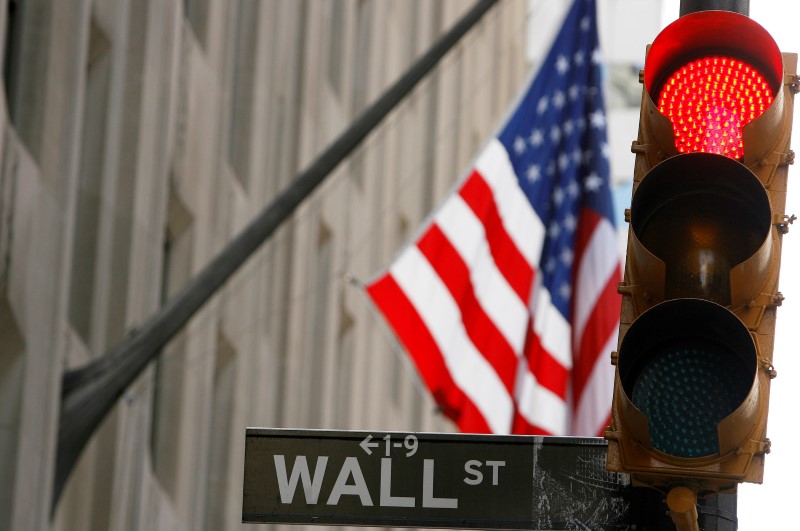
Investing.com-- U.S. stock futures fell in Asian trade on Friday after a stop-gap spending bill backed by President-elect Donald Trump was voted down in Congress, raising the prospect of a government shutdown.
S&P 500 Futures fell 0.4% to 5,912.50 points, while Nasdaq 100 Futures fell 0.5% to 21,263.0 points by 22:10 ET (02:10 GMT). Dow Jones Futures fell 0.3% to 42,661.0 points. Futures extended losses after falling slightly in Thursday evening trade.
The bill was assembled at the eleventh hour by policymakers to include Trump’s demands for higher government spending and a raised debt ceiling. But the spending bill was rejected in a 174-235 vote in the House of Representatives, with several Republican senators also openly defying the President-elect.
The new bill replaced a bipartisan deal to approve government spending, after Trump and Tesla (NASDAQ:TSLA) CEO Elon Musk came out in opposition of the old deal.
Government funding is set to expire at midnight on Friday, marking the beginning of a partial government shutdown that could disrupt operations ranging from border security to travel. The disruption is expected to be particularly dire amid increased travel trends during the holiday season.
Trump and Musk had balked at several provisions in the older bill which they perceived as wasteful giveaways to the Democrats. The revised version of the bill had dropped some provisions to increase lawmaker pay, but on Trump’s demands, proposed limits on national debts for two years- a scenario that would make it easier to pass his promised tax cuts.
A government shutdown presents another layer of uncertainty for Wall Street, which was already nursing steep losses from earlier this week after the Federal Reserve cut interest rates but flagged a substantially slower pace of rate cuts in 2025.
Focus this Friday is also on key upcoming PCE price index data for November. The reading is the Fed’s preferred inflation gauge, and is likely to factor into the outlook for interest rates.

By Emma-Victoria Farr and Andres Gonzalez
LONDON (Reuters) - Private equity funds in Europe, even though flush with cash, are thinking twice about buying businesses that could be difficult to sell and carefully working through their exit plans before making more acquisitions, bankers and investors said.
In one example, Brookfield walked away from making a binding offer for Spanish waste disposal firm Urbaser due to concerns over exit options, one source familiar with its strategy said. One reason was that it could eventually be too big to sell on, the person said.
A Brookfield spokesperson declined to comment. Urbaser owner Platinum Equity did not respond to a request for comment.
"In the last cycle, funds have done very well on the entry, very well on the execution, but the exit, that has been more difficult," said Nestor Paz-Galindo, UBS head of EMEA global banking and global co-head of M&A.
Big transactions will still take place in Europe, Paz-Galindo said, but are likely to be the preserve of fewer funds.
Bankers told Reuters they expect 2025 will see private equity funds under pressure to not only deploy record levels of unspent capital, but also to sell assets that they have been owning for longer than they have traditionally.
In Europe, the resale of companies from one financial investor to the next is proving difficult, and auctions of private equity-backed companies have seen fewer bidders, bankers and investors said, with sale processes also taking longer.
"There is concern that some assets are just simply too big, and we're seeing sponsors consider divesting divisions or stakes to reduce the size," Stephen Pick, Barclays (LON:BARC)' head of M&A in EMEA, said of how some firms are attempting to secure an exit.
Bain and Cinven are working on the IPO of German drugmaker Stada, which could be valued at around 10 billion euros ($10.50 billion), after talks over a sale to rival financial sponsor firm GTCR stalled, sources close to the matter said.
An M&A solution could still be a fallback option, one of the people said.
Bain, Cinven and GTCR declined to comment.
There are still deals happening, such as the sale by Switzerland's Partners Group of German metering firm Techem for 6.7 billion euros to U.S. asset manager TPG and co-investor GIC.
"There are a significant number of large portfolio companies that rely on IPOs for an exit, given there is currently no M&A market for them given their size," said Paz-Galindo, adding that equity capital markets remained an exit route for these.
Although there have only been a handful of big IPO exits this year, there are signs equity capital markets have been recovering gradually and bankers say that the window is opening, allowing private equity firms to consider share sales again.
By the end of the third quarter, only 9% of total private capital exits were IPOs, data from Preqin shows, up from 7% in 2023, which was the lowest level since 2008.
Meanwhile, the U.S. private equity market has been more active and is poised to see some larger deals in 2025 as financial sponsors face increasing pressure to return liquidity to their limited partners.
A regulatory environment anticipated to be more business-friendly under the second administration of President-elect Donald Trump is also expected to drive a surge in larger transactions, bankers and lawyers said.
BACKLOG
Total (EPA:TTEF) deal values involving financial sponsors in Europe, Middle East and Africa (EMEA) so far this year have reached $297 billion, up 23% on 2023 but still far off the peak of $509 billion in 2021, Dealogic data shows.
The value of shares sold on the public markets by all investors, including private equity, were only $146 billion so far this year across the region, down from $294 billion in 2021, Dealogic data provided by JP Morgan shows.
Selling on to another private equity owner is challenging, because, "many of the value drivers that private equity uses have already been realized," said Tibor Kossa, Goldman Sachs co-head of investment banking for Germany and Austria.
Still the pressure is on to return cash to investors.
"Private equity exits have obviously not been suspended, just postponed ... so we expect more to come, as the pressure by investors in private equity funds for capital returns continues to increase," said Christopher Droege, head of M&A for Germany and Austria at Goldman Sachs.
"There is a large backlog of companies that have been owned by funds for a comparatively long period," Droege added.
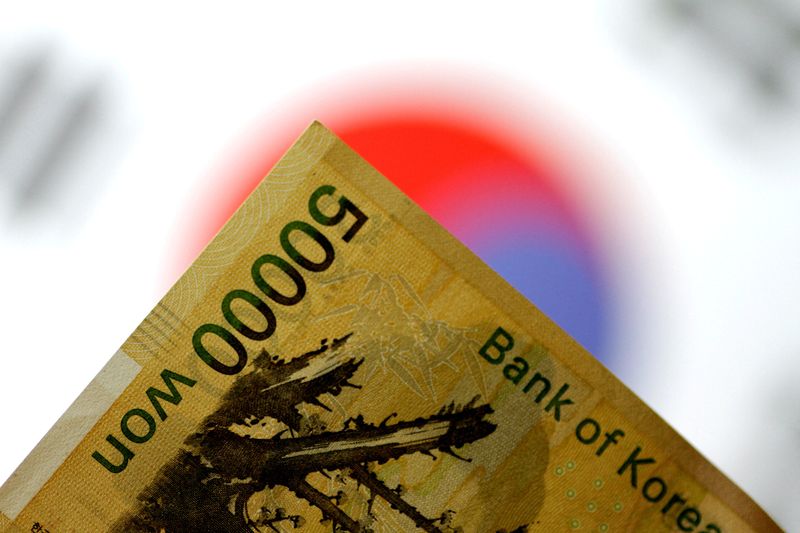
SEOUL (Reuters) - South Korea's financial authorities said on Friday they would loosen foreign exchange regulations to improve liquidity conditions in the currency market, as the won traded at a 15-year low.
"Strict regulations restrain the efficiency of foreign exchange management, and there is a need to take into account worsened foreign exchange liquidity conditions after recent events," the finance ministry said in a joint statement with the central bank and regulatory agencies.
The South Korean won on Thursday dropped to its weakest level in 15 years, weighed down by risk-averse sentiment after the U.S. Federal Reserve's cautious stance on more interest rate cuts as well as domestic political uncertainty.
According to the statement, the ceiling of foreign exchange futures contracts will be raised to 75% of capital holdings for local banks and 375% for Seoul branches of foreign banks, from the current 50% and 250%, respectively.
Measures also include allowing companies to take out loans in foreign currencies and exchange the funds for the won, if they are used for investing in facilities such as equipment, property and land purchases.
The ministry said it would implement the measures in a swift manner and consider expanding them after reviewing the effects.
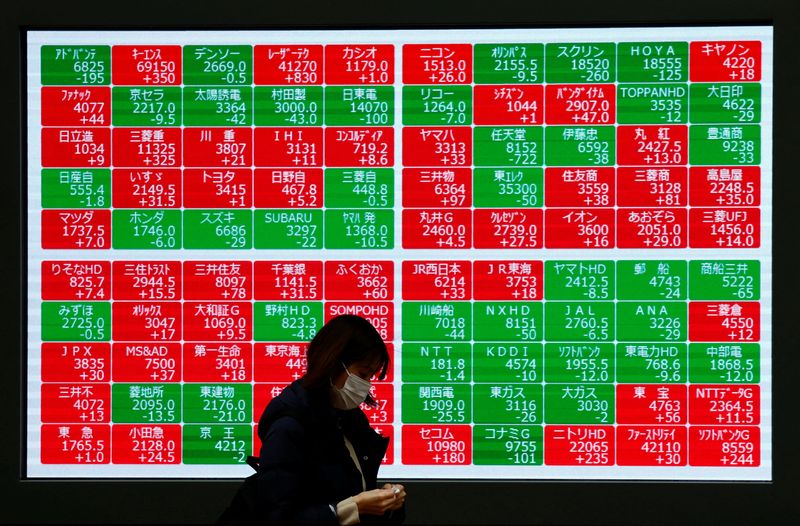
By Stella Qiu
SYDNEY (Reuters) - Asian shares were pinned near three-month lows on Friday as investors awaited key U.S. inflation data that could either ease or worsen concerns about price pressures, while the dollar towered at two-year peaks.
The closely watched inflation gauge - the U.S. Core Personal Consumption Expenditures - is due later in the day. Forecasts are centred on a monthly rise of 0.2% for November, and any upward surprises there could lead markets to further scale back bets for U.S. policy easing next year.
Futures imply just 37 basis points of rate cuts from the Federal Reserve in 2025, less than two cuts, after the U.S. central bank turned hawkish at its last meeting of the year. A rate cut is not fully priced in until June.
Rates now are expected to bottom out at 3.9% by the end of next year, much higher than just a few months ago. That outlook took a heavy toll on the Treasury market, where the benchmark 10-year yields jumped 40 bps over the past two weeks to cross above a key level of 4.5% for the first time since May. [US/]
In Asia, MSCI's broadest index of Asia-Pacific shares outside Japan fell 0.4% on Friday and was headed for a weekly drop of 2.6%. It is, however, up over 8% for the year.
Japan's Nikkei rose 0.2% on Friday and is up a whopping 16% for the year, in part due to the weakness in the yen, which has depreciated 12% in 2024 and drew intervention warnings again from Japanese authorities.
Global central banks have now wrapped up an eventful year of rate decisions, with the UK, Japan, Norway and Australia holding firm, and Switzerland and Canada implementing cuts of 50 basis points at their last meeting of the year. Sweden's Riksbank reduced its policy rate by 25 bps, as did the European Central Bank last week.
"Taken together, it's clear how much central banks are worrying about geopolitics and uncertainty in 2025," said James Rossiter, head of global macro strategy, at TD Securities. "They've nimbly set themselves up for more fluid policymaking in 2025.
"Ultimately, uncertainty is going to remain high, policy shocks significant, and markets are going to twist and turn potentially more than in the recent past. 2025 is going to be a ride."
China's blue chips slipped 0.3% while Hong Kong's Hang Seng edged up 0.2%. The People's Bank of China left its benchmark lending rates unchanged on Friday, matching market expectations.
In the currency markets, the dollar stood tall at a two-year peak of 108.45 against its major peers, enjoying some interest rate advantage.
It held near a five-month high at 157.5 yen, having jumped 1.7% overnight as Bank of Japan held rates steady and Governor Kazuo Ueda struck a dovish tone by saying it would take some time to assess the wage outlook and the impact of Trump's policies.
Data on Friday showed Japan's core inflation accelerated in November, supporting the case of a near-term rate hike. Swaps are split on the chance of a BOJ move in January, with 53% priced in.
The euro is down 1.3% for the week at $1.0364, threatening a key support level of $1.0331. Sterling is set for weekly loss of 1% to $1.2489 and on the verge of breaking a key level of $1.2484.
Treasuries look set for a fourth straight year of losses, with the 10-year yields up a whopping 70 bps this year. They climbed 17 bps this week to 4.57%.
The commodities market has also taken a hit because of a strong U.S. dollar. Oil prices fell on Friday, with U.S. West Texas Intermediate (WTI) down 0.5% to $69.06 and 2.7% lower for the week.
Gold prices are set for a 1.9% fall this week to $2,598 per ounce.

(Reuters) - A gauge of manufacturing activity in the U.S. Mid-Atlantic region slid to the lowest in nearly two years in December, with new orders and shipments both contracting in an indication the factory sector remains in a slump.
The Federal Reserve Bank of Philadelphia said on Thursday that its monthly manufacturing index fell for a second straight month to negative 16.4 - the lowest since April 2023 - from negative 5.5 in November. The median forecast among economists polled by Reuters was for a reading of positive 3.0. Negative readings indicate a contraction in activity.
The report's new orders index tumbled to negative 4.3, the lowest since May, from plus 8.9 in November.
Factory managers continued to be optimistic about prospects in six months' time but their growth outlooks nonetheless softened from a three-year high in November.
The regional report from the Philly Fed suggests the factory sector, accounting for just over 10% of the economy, is continuing to struggle finding its footing in the wake of the Federal Reserve's interest rate hikes in 2022 and 2023. While the Fed has shifted to rate cuts in the last half of this year, it is not expected to ease that much further from here and market-based measures of borrowing costs remain notably higher than they were in early 2022 and continue to exert pressure on investment.
On Tuesday the Fed reported that manufacturing output in November rebounded less than expected from a month earlier and production declined 1.0% year-on-year.
Also clouding the outlook is President-elect Donald Trump's ambitions for hefty new tariffs on goods imported from abroad, which could trigger counter levies to be imposed on American exports by U.S. trading partners.
(This story has been corrected to remove the word 'unexpectedly,' in paragraph 2)
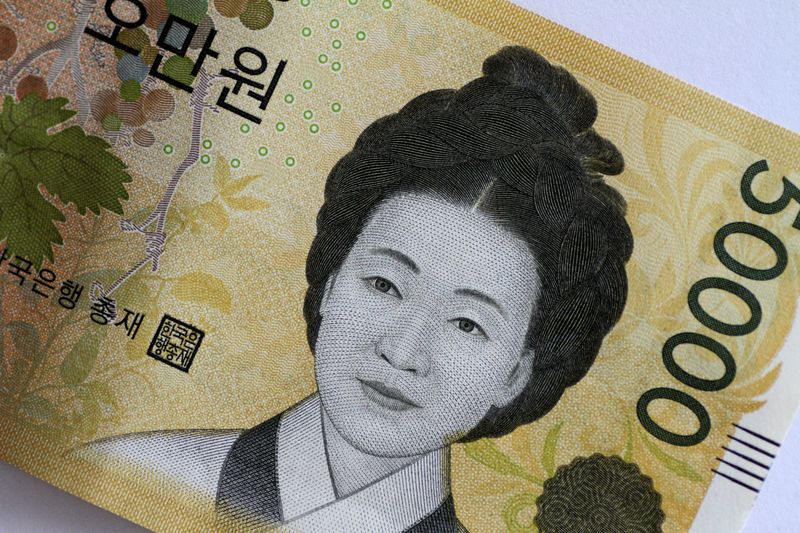
By Jihoon Lee and Yena Park
SEOUL (Reuters) -The South Korean won dropped to its weakest level in 15 years on Thursday, weighed down by risk-averse sentiment after the U.S. Federal Reserve's cautious stance on more interest rate cuts, as well as domestic political uncertainty.
The won was quoted at 1,448.9 per dollar in onshore trade as of 0518 GMT, after opening the session at 1,453.0 per dollar, 0.96% lower than the previous day and the weakest since March 16, 2009.
The U.S. central bank cut interest rates on Wednesday, as expected, but Federal Reserve Chair Jerome Powell said more reductions in borrowing costs now hinged on further progress in lowering stubbornly high inflation.
U.S. central bankers now project they will make just two quarter-percentage-point rate reductions next year, half a percentage point less than anticipated in September, with higher projections of inflation for the first year of the new Donald Trump administration.
The hawkish stance pushed up the dollar and added to downward pressure on the won, which had already been weighed down by domestic political turmoil after impeached President Yoon Suk Yeol's short-lived martial law attempt earlier this month.
Taking into account the negative economic impact of the Dec. 3 martial law order, the Bank of Korea flagged on Wednesday downside risks to its economic growth forecasts for this year and next year.
So far in December, the won has weakened 3.9% against the dollar, extending losses for a third consecutive month.
The won, down 11% year-to-date, is the worst performing emerging Asian currency of the year and is set to record its worst year since 2008.
Prior to market open on Thursday, South Korea's finance minister said the government and the central bank would swiftly and boldly deploy measures to stabilise financial markets if volatility was seen as excessive.
"It is suspected that authorities are defending the 1,450 figure, making it difficult to short the won around the level," one local currency trader said.
To help ease pressure on the currency, the country's Financial Services Commission asked local banks to flexibly manage foreign exchange transactions and loans.
The Bank of Korea expanded its foreign exchange swap line with the National Pension Service, a market stabilising tool absorbing dollar demand stemming from growing overseas investment by the world's third-largest pension fund.
In the stock market, the benchmark KOSPI dropped as much as 2.5%, as foreigners sold local shares.
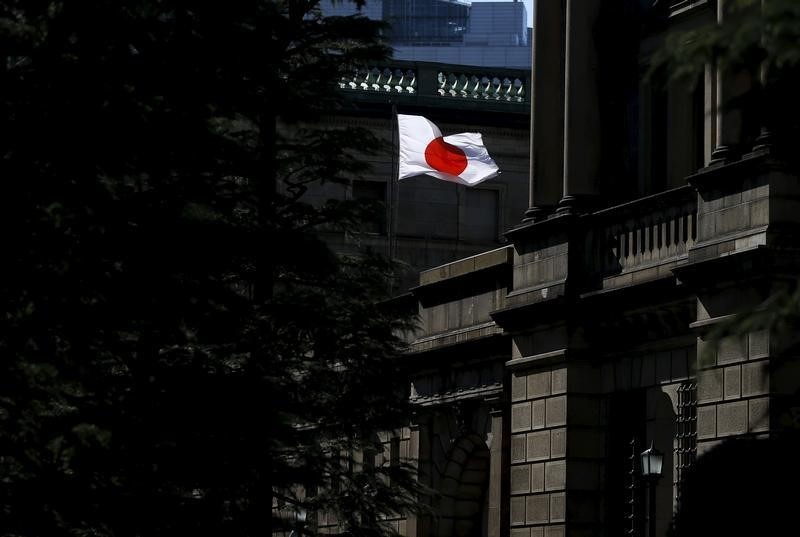
Investing.com-- The Bank of Japan kept interest rates unchanged in a nearly unanimous decision on Thursday, as policymakers remained cautious over Japan’s economic outlook and the path of inflation.
The BOJ kept its benchmark short-term policy rate at 0.25%, in line with a Reuters poll. Eight of the BOJ’s nine rate-setting board members voted in favor of the decision.
BOJ member Naoki Tamura was the sole dissenter, calling for a 25 basis point hike on concerns over rising inflation.
BOJ Governor Kazuo Ueda is now set to speak at 01:30 ET (06:30 GMT).
The BOJ said it expects consumer price index inflation to pick up in 2025, amid a virtuous cycle of higher wages and increased private consumption. The effects of recent government subsidies to lower living costs are also expected to wane in the coming year.
Markets were somewhat split over Thursday’s decision, with some analysts forecasting a 25 basis point hike amid recent signs of rising inflation in Japan. But economic activity in the country has softened this year, as strong private consumption was largely offset by dwindling business spending.
Increased political uncertainty in Japan also likely drove Thursday’s hold, with the BOJ expected to face some resistance from the government towards raising interest rates further.
Thursday’s hold comes after the BOJ hiked rates twice in 2024, bringing an end to nearly a decade of ultra-loose monetary policy. The move was driven chiefly by Japanese labor unions negotiating a bumper increase in wages- a trend that is expected to happen again in 2025.
Analysts forecasting a December hold said the central bank was still likely to raise rates further in the coming months, with a hike coming as soon as January or March. Wage negotiations in spring will be a key point of focus for the central bank.
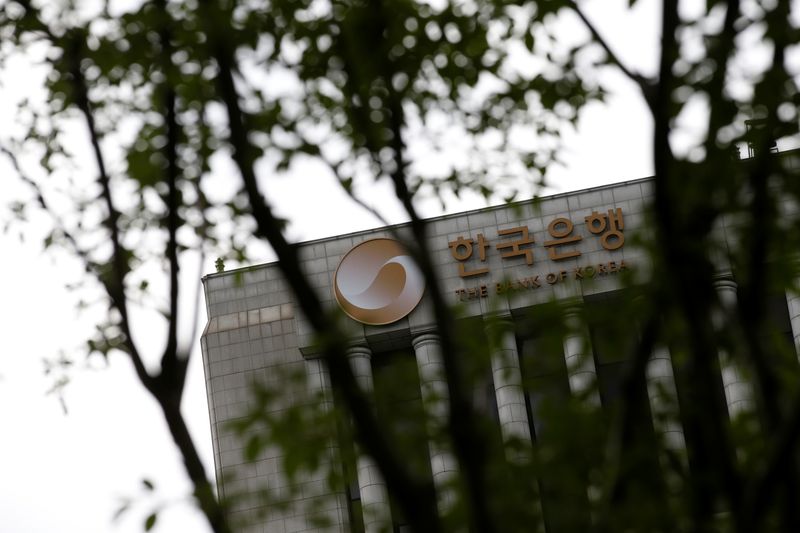
SEOUL (Reuters) - South Korea's potential economic growth rate is estimated to have fallen to around 2% and is projected to fall further below 1% by the late 2040s due to a lack of innovation and inefficient resource allocation, the central bank said on Thursday.
The Bank of Korea (BOK) estimated in an analysis that the potential growth rate, the maximum growth an economy can achieve in a year without triggering inflationary pressure, was around 2% from 2024 to 2026.
The rate has been falling in trend, from the lower 5% range in the early 2000s to the mid-to-lower 3% range in the 2010s and to mid-2% levels by 2020, the BOK said, citing lack of innovation and inefficiency in resource allocation.
In the long-term, the rate is projected to fall to the mid-to-lower 1% range in the 2030s and to around 0.6% by the late 2040s, according to the report.
"But, the abovementioned result is not a given condition and can differ greatly depending on how we respond through structural reforms," the BOK said.
Major reforms that could boost the economy's potential growth include building an ecosystem for innovation, balanced developments between the capital area and other regions of the country, and work-life balance policies, the bank said.
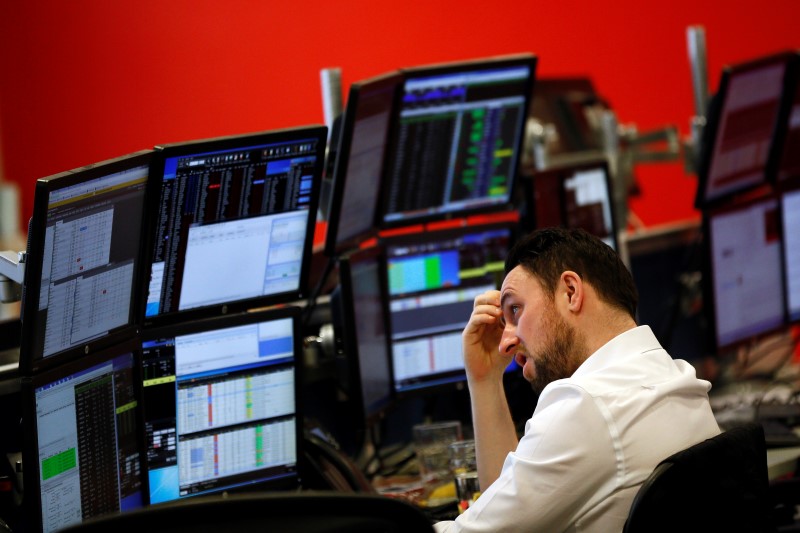
Investing.com-- U.S. stock index futures steadied on Wednesday evening after a sharp fall on Wall Street as the Federal Reserve lowered interest rates as expected but indicated a slower pace of easing in 2025.
Federal Reserve officials lowered interest rates for the third time in a row on Wednesday but projected fewer cuts in 2025 amid sticky inflation and resilient economic growth.
S&P 500 Futures were largely unchanged at 5,941.0 points, while Nasdaq 100 Futures inched lower to 21,475.25 points by 19:18 ET (00:18 GMT). Dow Jones Futures were marginally higher at 42,827.0 points.
Fed officials project only two more cuts in 2025
The Fed cut interest rates by 25 basis points at the end of its two-day meeting on Wednesday, bringing down the borrowing rate to a range of 4.25%-4.50%.
Chair Jerome Powell emphasized that further reductions depend on progress in curbing persistent inflation, reflecting policymakers' adjustments to potential economic shifts under the incoming Donald Trump administration.
Policymakers now see the benchmark rate falling to 3.9% for next year, suggesting just two 25 bps rate cuts, compared with a prior forecast in September for four cuts.
The Federal Open Market Committee (FOMC) economic projections showed that inflation was still a long way from its 2% target, with the targeted metric expected to end this year at 2.4% and at 2.5% next year.
It also showed that policymakers now expect slightly higher economic growth and lower unemployment next year compared to their projections three months ago.
Wall St slumps with tech logging heavy losses
The prospect of interest rates remaining higher for longer than expected sent Wall Street indexes sharply lower on Wednesday, with heavy losses in the technology sector. Investors also locked-in recent profits in tech stocks, after they rallied sharply over the past week.
Market darling NVIDIA Corporation (NASDAQ:NVDA) fell more than 1%, sinking deeper into correction territory following a 10% plunge from its recent peak.
Tesla Inc (NASDAQ:TSLA) slumped more than 8%, and Intel Corporation (NASDAQ:INTC) lost nearly 6%, while Broadcom Inc (NASDAQ:AVGO) shares plunged 7% on Wednesday.
In the aftermarket trade, Micron Technology Inc (NASDAQ:MU) shares plunged nearly 16% after the company issued a revenue outlook that came in below analysts’ expectations.
The S&P 500 declined 3% to 5,872.16 points, while the NASDAQ Composite fell 3.6% to 19,380.87 points.
The Dow Jones Industrial Average fell 2.6% to 42,326.87 points, its 10th consecutive session of declines, marking its longest losing streak since 1974.

